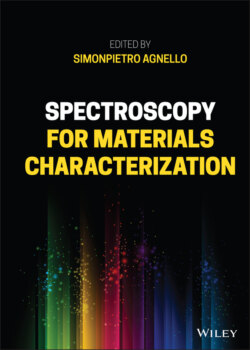Читать книгу Spectroscopy for Materials Characterization - Группа авторов - Страница 39
2.1.5 Vibrational Structure
ОглавлениеTo derive the properties of the optical spectra, the overall effect of band and localized vibrations must be taken into account. Since the coupling to each mode is independent from all the others, the total transition probability can be factorized in the product of the transition probabilities for each mode. If we consider a single localized vibration of frequency Ω, and f band vibrations, the transition probability from (I,λ,n s ) to (II,λ ′,m s ) is:
(2.49)
Figure 2.3 Configuration coordinate diagram showing the potential energy of the ground and excited electronic states for three values of the Huang–Rhys factor for the localized vibration, The distributions of the vibronic transition probability are also reported.
Source: Modified from Skuja [11].
I and II are the electronic states, λ and λ ′ denote the localized vibration, n s and m s are the sets of the band vibrations, is the transition probability between the localized vibration levels in the ground and excited electronic states, and is the transition probability between the band vibration levels. In the approximation kT ≪ ℏΩ, λ = 0 and the previous equation averaged over the band vibration states is:
(2.50)
where ω is the frequency of the transition n s → m s .
Equations (2.49) and (2.50) determine the spectral features of the whole optical band. The intensity of transitions coupled to the localized vibration going from λ = 0 to λ ′ (λ ′ = 0, 1, 2…), , is not influenced by the interaction with the band vibrations so that is distributed according to the Poisson distribution of Eq. (2.48). The band vibrations, in turn, give rise to an internal lineshape, L vib(ω, T), featuring the properties of the vibronic band in the absence of a localized vibration: a ZPL and a vibrational background. Upon increasing temperature, the ZPL intensity decreases and the vibrational background increases so that the total intensity remains constant. L vib(ω, T) follows a similarity law: the overall spectrum is a series of replicas of vibronic lines spaced apart by λ ′Ω (λ ′ = 0,1,2, …) from the electronic transition. The intensity of each replica is given by the factor governed by Eq. (2.48); therefore, the absorption transition has the expression:
(2.51)
For the luminescence transition, the similarity law also applies: the overall spectrum is a series of replicas of the vibronic bands L vib(ω, T) spaced apart by −λΩ (λ = 0,1,2, …) from the electronic transition:
(2.52)
and describe the spectral shape of a single defect and are therefore referred to as a homogeneous property.
We note that, when the thermal excitation of the localized vibrations is taken into account (kT ∼ ℏΩ, λ≥0), two substantial differences emerge: the replicas L vib(ω, T) appear in the anti‐Stokes region of the spectrum and the factor is replaced by a thermally averaged one. In this case, since the localized vibrational states with λ > 0 contribute to the spectrum, both absorption and luminescence bands widen with increasing temperature. Given a single localized mode of frequency Ω linearly coupled with the electronic transition (Huang–Rhys factor ), the width of the optical band, measured as FWHM, is given by:
(2.53)
